
19 minute read
The Style of Wight Family Guide



It’s not just hibernating hedgehogs who are emerging from a long winter nap: morning has finally broken and we are so very ready for all the many delights of Spring. This happy collection of features is full of things to make, read, spot, and buy as we look forward to the longer and brighter days ahead on our beautiful Island.
Tell your story with top writing tips from the IW Story Festival – pages 86-87
Rebel Beauty for Teens: WIN a copy of this fabulous guided journal – pages 88-89 Become a Hedgehog Champion – pages 81









Activity:

naturally dyed Easter eggs
This infinitely-Instagrammable activity has been on our ‘wholesome Easter holiday activity’ list for a while now; this year, we’re making it happen – happily forfeiting onion eyes and turmeric fingernails in determined pursuit of that quintessential symbol of spring: a bright and beautiful bowl of naturally dyed Easter eggs.
As we’ve discovered, dyeing eggs using everyday ingredients – with not an artificial colour in sight – is part science, part art. Online (we scoured Pinterest so you don’t have to) you will find colour swatches, wheels and charts galore; personally, we think the best rainbows are a little off-kilter, and experimentation yields the most satisfying results. With that in mind, the Style of Wight team have compiled their own fully customisable guide to creating your own basket full of naturally dyed Easter eggs.
The process 1. Fill a saucepan with your chosen dye matter (e.g. cabbage, turmeric, onion skin), cover with water and bring to the boil. Turn the heat to low and simmer until the colour has deepened (up to an hour). 2. Remove the dye from the heat and cool to room temperature. 3. Pour cooled dye through a mesh strainer into individual bowls or jars and add 1 tablespoon of white vinegar for each cup of dye liquid to help set the colour.
4. Add cooled hard-boiled eggs to the dye and refrigerate to infuse until desired colour is reached; remove and gently pat dry. 5. Take photos (obviously). Eat and enjoy!
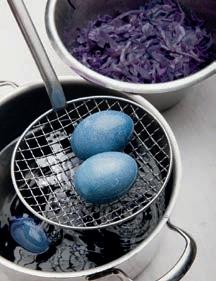
Colour guide
White onion skins orange to burnt terracotta Red onion skins lavender to red
Beetroot pink to maroon Red cabbage green to blue Coffee sepia to mocha Chamomile tea scotch butter to daffodil yellow Turmeric sunshine to mustard
Blueberries soft dusk to duck egg
Top tips
Naturally dyed eggs have a matte finish. For a little more lustre, rub with a drop or two of coconut or olive oil Remember that colour deepens with time: a three-hour cabbage soak will result in a lovely powdery blue; leave it overnight for a richer teal Pale colours work best on white eggs; brown eggs are good for creating darker hues
Bespoke mud kitchen Handcrafted from reclaimed wood or pressure-treated timber, with real working tap for endless mud soup/petal pie creations. From £75, Al’s Workshop IW, Bembridge Facebook: @alsworkshopiw
Cotton string rainbow We’re totally under the spell of this dreamy rainbow wall hanging. £12, Pocket Full of Pebbles, Cowes Facebook: @pocketfullofpebbles


Style picks
JuniorA miniature stack of springtime ‘wants’ for your extended tribe, handpicked by the Style Team from a selection of Isle of Wight makers, shakers, and independent retailers.

Peter Rabbit placemats With dippy-egg resistant surface for Easter morning surface for Easter morning and every morning after. £24.95, Hursts Instagram: @tryhurstfi rst Mini rainbow rolltop rucksack Classic Wyatt & Jack design for mini folk: each one of these teeny rucksacks is completely unique and made to order – for (sustainable) spring strolls. £39, Wyatt & Jack Junior Instagram: @wyattandjack_junior





Organic footed leggings Handmade on the Isle of Wight from organic jersey cotton, these footed leggings will keep foxy toes toasty. Available from newborn to 18 months.

From £14, Zoe + Zach Instagram: @zoe.andzach


Island Babe sweatshirt Supersoft and made to order, we love the simple pastel designs of these cosy Island-inspired jumpers; perfect for the longer and lighter days to come. Available in ages 2-12.

£18, Mint + Wight Instagram: @mintandwight
BigJigs garden tool belt BigJigs garden tool belt For budding gardeners and For budding gardeners and aspiring smallholders. £6.99, The Sports Shop, Shanklin
thesportshop.co Bright yellow wellies Make a splash and support our local lifeboat crews and stations at the same time in these super-sunny welly boots with classic sailing stripes. Available in ages 2 – 8. £15, RNLI – shop.rnli.org Instagram: @rnli
Bunny shelf This cuter-than-cute nursery shelf is crafted from paulownia wood; known in Japanese mythology as The Princess Tree and traditionally gifted on the birth of a baby girl. £31.50, BouChic, Ryde Instagram: @bou.chic



Spring wildlife spotting with The People’s Trust for Endangered Species
As sleepy creatures awaken and dormant wildlife stirs, now is the perfect time to sit up and take notice of the life happening right outside our windows
Sadly, many of Britain’s mammals are under threat, but recording sightings of the species we spot in our own gardens can help conservationists protect their future. Starting from the 29th March, wildlife charity People’s Trust for Endangered Species (PTES) is calling for volunteers to take part in its annual Living with Mammals survey to build a clear picture of how our wildlife is changing. From red squirrels and red foxes, to hedgerow dormice and handsome hedgehogs, here are some of the wildlife you might just spot when you look closely and quietly:
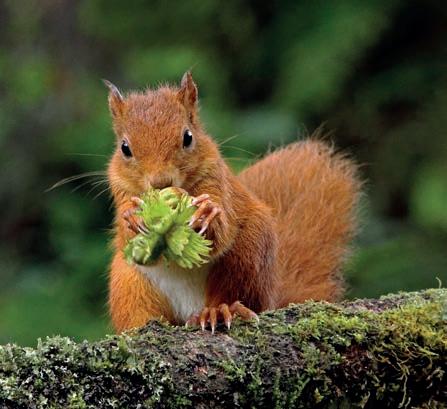
Image credit: Dave Bevan Image credit: Ronnie Stokes
Rabbits
Watching baby rabbits – which are called kittens – frolic and have fun in the first flushes of spring is a wonderful thing. Although the wild rabbit population is large, it has fallen significantly over the last ten years, so it’s vital that we keep a cautious eye on numbers.

Red squirrels
Here on the Island, we are exceptionally lucky to be able to spot our native – yet endangered – red squirrels from our kitchen windows. It’s still really important to note these sightings, so that they are fed into national data sets. Squirrels have supersensitive hearing, so always watch their antics from a safe distance so you don’t disturb them.
Hazel dormouse
Think yourself very lucky indeed if you manage to spot a shy little dormouse emerging from its long winter nap. Recording your sighting will mean that scientists can try to understand how climate change might be affecting hibernation patterns.
Image credit: iStockphoto.com & Artsiom Malashenko
Bats Red fox
Badgers
The Isle of Wight is home to many of the UK’s endangered bat species, including the Pipistrelle bat, which is small enough to fit into a matchbox. Best seen after dusk, the Pipistrelle is often seen around street lighting, or feeding on tiny insects above garden ponds. Though you’re more likely to encounter Fantastic Mr. Fox at night, daytime garden sightings are perfectly possible – in the springtime, you might even catch sight of young cubs. Amazingly, foxes communicate with each other using up to 28 groups of sounds, as well as facial expressions, body postures and scent markings.
Image credit: Graham Williams, for People’s Trust for Endangered Species (PTES)
Although these expert tunnel architects are not currently threatened for natural reasons, badgers face man-made threats from government culling programmes, which also impact the food chain and wider ecology. To find out more about how you can protect these beautiful animals, visit ptes.org
Image credit: Seth Jackson
Hedgehogs
These much-loved spiny creatures are in trouble, but understanding why is complicated. Like all mammals, they need plenty of food and shelter for nests, as well as places to hide from predators. Luckily, there are lots of practical things you can do to be a hedgehog helper, including recording any sightings with the Living with Mammals survey.
Image credit: Stephen Oliver


Become a hedgehog champion
Get your garden Hedgehog ready with these top tips from wildlife charities People’s Trust for Endangered Species (PTES) and the British Hedgehog Preservation Society (BHPS): • Create Hedgehog Highways; link your garden with 13cm gaps in fences to allow hedgehogs access to as many neighbouring gardens as possible. • Leave a patch of the garden wild and undisturbed, providing nesting materials and insect prey. • Leave out food and water; meaty cat or dog food will supplement a hedgehog’s natural diet of creepy crawlies. Don’t forget a shallow dish of clean fresh water too. • Create safe nesting sites with a log pile or more structured hedgehog house . • Make sure your pond has shallow sides or an escape ramp. • Remove litter and tie up loose garden netting to prevent hedgehogs getting tangled and trapped. • Stop using chemicals, lawn treatments and slug pellets. • Check areas carefully before strimming/mowing to avoid nasty accidents. • Take care with bonfires; build or move a bonfire on the day of burning so that there are no hidden hedgehogs inside.
To take part in the 2021 Living with Mammals survey, visit ptes.org/LwM or record your mammal photos on social media using #LivingWithMammals
Family foraging oraging
This Spring we’re putting the purpose back into our family walks: discovering (and rediscovering) the joyful abundance of wild food that grows across our Island’s coastline and countryside, from harbour walls to woodland floors
in season: wild garlic Wild garlic is the perfect starter fi nd, not just because it grows particularly abundantly here on the Island, but also because you’ll smell it before you see it! Trust your nose; its fragrant garlicky scent will rule out any mistaken identity with the poisonous Lily-of-the-Valley.
Recipe idea:
There are many things you can theoretically do with wild can theoretically do with wild garlic, but cooking with younger garlic, but cooking with younger children might not be the time to children might not be the time to attempt a twice-baked souffl é. attempt a twice-baked souffl é. Instead, for an easy midweek Instead, for an easy midweek ‘pasta pesto’, simply add your ‘pasta pesto’, simply add your wild garlic leaves (washed), wild garlic leaves (washed), some hazelnuts (a handful), some hazelnuts (a handful), olive oil (a glug), and lemon juice (a squeeze) to a food processor – bickering over whose turn it is to press the button optional – and whizz together before stirring through their pasta shape du jour.



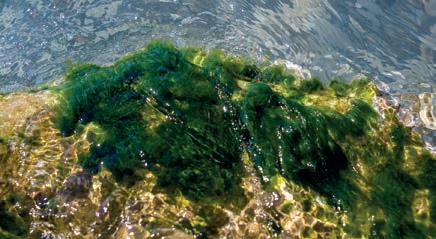

Tell me where: wild garlic can be found in almost every wooded area across the island – guaranteed spots include Shorwell Shute and Briddlesford Copse.


Tell me where: any beach that has rockpools exposed at low tide – think Bembridge over Ryde, and Colwell Bay over Sandown.


in season: seaweed

Technically edible all year round, the morning after a spring storm offers up a freshnessguaranteed time to forage for this seaside superfood. With so many varieties, deciding what to pick and how to prepare it can be overwhelming, so here are just two of our favourites.


Recipe ideas:
Sea lettuce – easily identifi able as a rather limp-looking but very bright green lettuce leaf – can be found mostly attached to rocks or in rockpools, and makes an excellent colourful topping on homemade pizza. Sugar kelp – when baked into crinkly crisps on a very low heat and seasoned with some Isle of Wight sea salt and rosemary from the garden – makes a viable (and packaging free!) Pom-Bear alternative.







in season: sea beet
Sea beet is, in fact, not a ‘beet’ Sea beet is, in fact, not a ‘beet’ at all, but more like a sturdier at all, but more like a sturdier and shinier wild spinach that and shinier wild spinach that grows robustly along our grows robustly along our coastal paths, on saltmarshes coastal paths, on saltmarshes and near shingle beaches. and near shingle beaches.
Tell me where: for us, sea beet means St. Helens; though it can be found on, around, and above most of our coastal haunts – from Freshwater Bay to Newtown.
Tell me where: no map needed (in fact, it’s probably more helpful to say where NOT to find dandelions; go wild in fields, gardens and nature reserves, not the pavement).

in season: dandelions
Recipe idea:
A bit tough for kids to eat as a standalone vegetable, sea beet deserves a special mention for making the perfect spring green soup when slowly simmered together with vegetable stock and coconut milk.
Dandelions really are the superheroes of spring: bursting with cheer, boisterously blooming all over the place the second winter is behind us. And best of all? Completely edible, from stalk to fl ower. Of course, all the normal rules apply – never eat anything grown where it might have been sprayed with pesticides – but dandelions are so plentiful that parents don’t have to worry about over-enthusiastic pickers depleting nature’s own stocks.
Golden rules of foraging



Recipe idea:
We like to save the leaves for the pet guinea pigs, and scatter the saffronyellow petals for an almost Holi-like decoration on springdecoration on springveg risotto.
no map needed (in fact, it’s probably more helpful to say where NOT to find dandelions; go wild in fields, gardens and nature reserves, not the pavement). • Foraging is fun, not a free-for-all: take only what you really need – from plentiful populations – and leave plenty behind for the birds and other wildlife. • Pick sparingly from public spaces or common ground; the Woodland Trust, for example, allows foraging for personal use, but always check to make sure you’re not on privately owned land. • Steer clear of well-trodden dog-walking paths (for obvious reasons), roadsides and houseboat-populated harbours – many plants absorb pollutants from the surrounding earth, air and water. • If in any doubt, take a picture and consult an illustrated guide (or download a plant identifi cation app) before eating – aim for 101% certainty.
A day in the life of a Dairy farmer

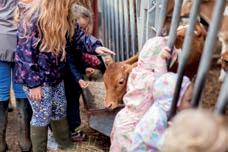
Come rain or shine, lockdown or not: a farmer’s work is never done. Here, the team at Wootton Bridge’s Briddlesford Lodge Farm give us a unique behind-the-gate look at the daily routines of the ‘best job in the world’
Every day at 4.30am it’s time to get the cows in for milking. It’s still dark outside, and we’re often too busy to notice when the sun comes up at 6:30!
First, we check the late pregnancy mums in the maternity ward: sometimes, there’s an unannounced baby calf or even twins and occasionally we have to be midwife too.
As the noisy milking machines rattle into life, the eager cows jostle to get into the parlour first. Here they have some tasty ‘cattle cake’ as they happily let their milk down.
Our pedigree Guernseys average 20 litres of rich creamy milk per day. Ten cows can be milked at a time, with each cow taking between 5 and 10 minutes. When the last of the 150-cow herd has been milked, we clean down the parlour and the fresh milk is taken around to the processing dairy, for pasteurisation, bottling, or cheese and butter-making. In the springtime, the cows go straight out to grass, and we get on with feeding more than 50 hungry – and noisy – calves before they snuggle down in their cosy straw beds. Finally, after around six hours work, it’s time for our own breakfast – a cappuccino and bacon bap from our very own Bluebells Café! After breakfast, there’s more work: tractors must be greased and serviced ready for dung spreading, plus plenty of field work – from fencing to ditching – to keep on top of. At about 3pm, the cows come back to the parlour for the second milking of the day. It’s a long day, but fulfilling work, and when the weather is fine, it can seem like the best job in the world. Here at Briddlesford, we can’t wait to welcome you all back, to see what we do – on our ‘Welly Wednesday’ tours or school trips – and enjoy the hospitality of our staff in Bluebells Café. Meanwhile, please don’t forget to visit our farm shop, where you can see some baby calves and buy delicious dairy products from our beloved cows.
briddlesford.co.uk
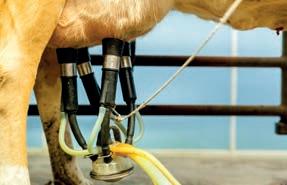
Adventures to the power of with the Isle of Wight Triplets three
Image credit: Jennifer Stone

Family life on the Isle of Wight is triple the fun with three boys in tow
Six years ago, Tori Stratton and her husband Andy left their London lives behind; buying a pictureperfect cottage down a country lane in rural Cowes in anticipation of a laid-back family life on the Island where they both grew up
But neither of them imagined – as they found out during Tori’s 12-week pregnancy scan – that their family would be expanding quite so much, quite so quickly. Today, their cosy cottage is filled with three sets of everything: from splash suits and superhero costumes to wellies and water bottles.
Identical triplet brothers Ollie, Jakey and Toby are now four, and will start school this September. The boys were born prematurely and spent six weeks in hospital before coming home: and it was during those very early days of motherhood that Tori started using Instagram as a way of recording both the boys’ milestones and their journey as a family of five. “Only 0.03% of all births in the UK are triplets,” says Tori, “so it’s been wonderful to connect with other ‘multiple mums’ through social media, and support each other through what can be an overwhelming and unusual parenting journey.” Tori recalls how “for the first two years we would push our triplet pram up and down our bumpy lane two or three times a day – whatever the weather – just to get them all to nap at the same time! Then we’d rush home, get the kettle on and breathe a sigh of relief until the first one woke and the relentless feeding and nappy changing would start all over again.” Since then, she has amassed a following of almost 50,000 people from all over the world, sharing snippets of their daily lives and adventures at home and all around our beautiful Island.
The triplets attract comment and attention wherever they go. “We would often meet the same people who would look in at them, remarking on how much they’d grown,” says Tori. She is grateful for the strong sense of community on the Island: when the boys were younger, Sainsburys designed a bespoke ‘triplet trolley’ so that she could do her weekly shop in their Newport stores. On what she calls her ‘days off’ from parenting, Tori works in an emergency triaging role for the Isle of Wight Ambulance service; a continuation of her 14-year career as an NHS paramedic. “I love my job more than ever” she says, having worked continuously throughout the Covid-19 pandemic response. “I’m immensely proud to be part of such a strong team.” The Island, Tori says, is the perfect place to raise a young family. “I don’t doubt the triplets will have a very strong connection to the Island throughout their lives. “I hope we manage to make them feel secure enough in their upbringing to have the confidence to leave and travel the world, but to recognise the value of home.”

Three is the magic number for the Stratton family
Follow the triplets’ journey on Instagram @isleofwight_triplets










